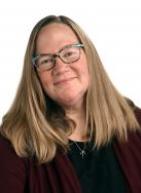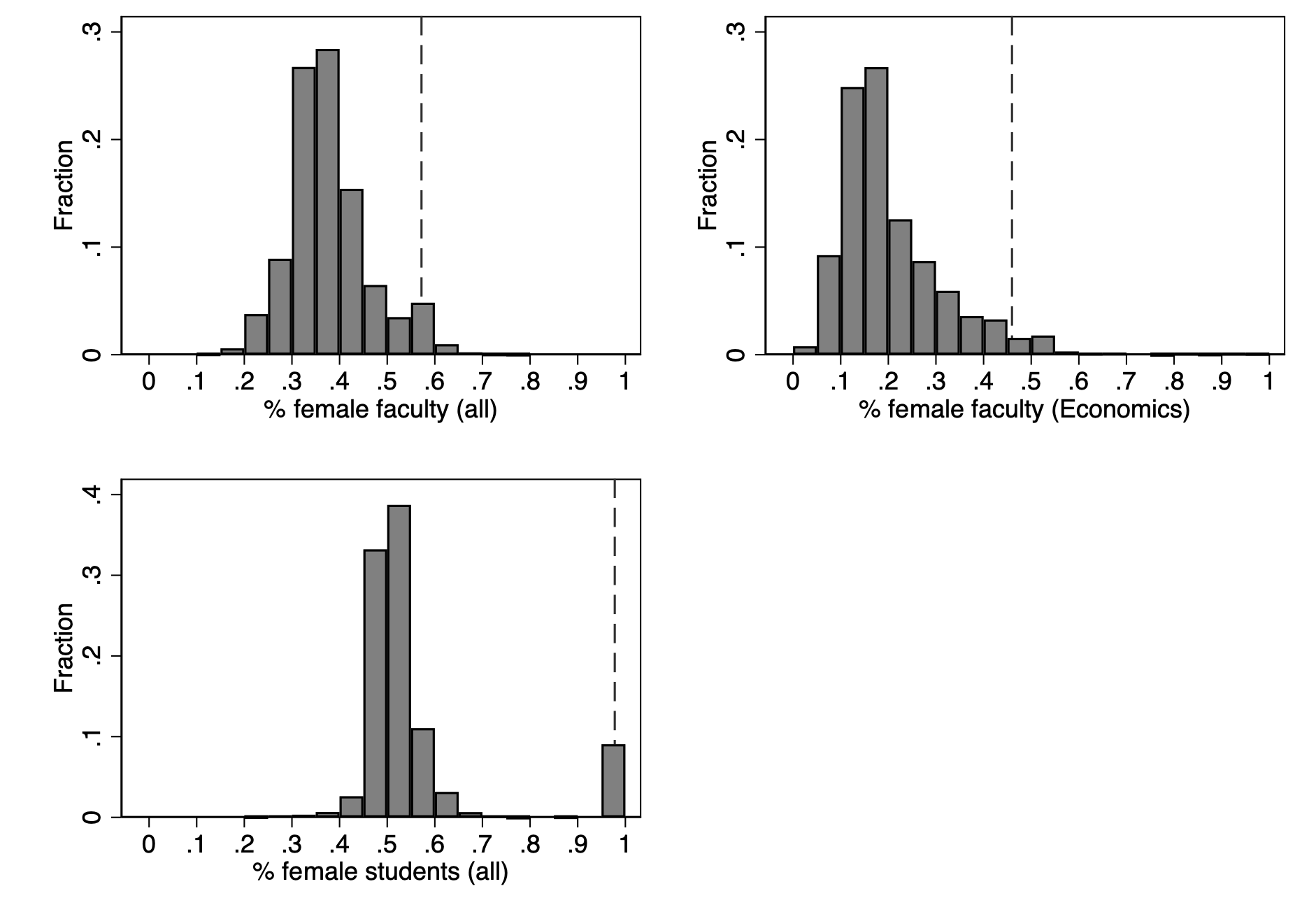The recent Supreme Court decision striking down affirmative action in college admissions has intensified discussions about how to achieve diversity in higher education. While the affirmative action decision will have important implications for college admissions, it is important to understand that diversity considerations cannot stop after the admissions decisions are over. Women, who have overtaken men in college attendance, continue to be underrepresented in mathematically intensive majors, like economics. This matters because the choice of undergraduate major has profound effects on subsequent graduate work and labour market outcomes (Bleemer and Mehta 2022, 2023, Altonji et al. 2012, 2016, Humphries et al. 2022, Stange et al. 2022).
Beyond the fact that studying mathematically intensive subjects tends to lead to more lucrative careers, and potentially even careers that are more ‘family-friendly’ (Goldin 2014), diversity in economics is particularly important. The Federal Reserve System has emphasised the importance of diversifying economics along many dimensions, as evidenced by support for conferences on “Diversity, Equity, and Inclusion in Economics, Finance, and Central Banking,” and “Women in Federal Reserve System Economic Research,” and support for research into pipeline issues (Bayer and Wilcox 2017). As former Fed Chair and current Treasury Secretary Janet Yellen noted in 2019, “[d]iversity is important in insuring that the research that is done within economics appropriately reflects society’s priorities”. When institutions that set the economic course of the country employ economists who reflect the experiences of society, the topics studied and the policy implications derived from research will be more meaningful to the society as a whole. Research finds again and again that representation matters (Bayer et al. 2016, Hessami and Baskaran 2020).
The field of economics continues to lack gender, race and ethnic diversity, and diversity along socioeconomic lines (Bayer and Rouse 2016, Shultz and Stansbury 2022). There have been a number of studies examining whether various types of interventions can address this (Avilova and Goldin 2023, Bayer et al. 2019, Becker et al. 2016, Grogger et al. 2015),
as well as broader STEM-targeted interventions (Ho et al. 2022). Deciding not to pursue an undergraduate major may come from lack of interest, lack of information about what it entails, lack of understanding of the labour market and other implications of the choice (Marinescu et al. 2017), lack of skills to successfully complete that course of study, or the belief that one is not suited to the study because of lack of role models or peers, amongst other reasons.
Our recent paper (Butcher et al. 2023) applies a narrow lens to this broad issue: we examine whether women’s colleges, and in particular Wellesley College (either alma mater or employer to all the authors), affect major choice. We are not the first to ponder whether specialised undergraduate institutions, in fact, do what their admissions brochures claim. There is renewed interest in the important role of Historically Black Colleges and Universities (HBCUs) in improving outcomes and diversifying professional occupations in the US (Price and Viceisza 2023, Edmonds 2022, Gasman et al. 2017). In the wonderfully titled, “When Sarah meets Lawrence: The effect of coeducation on women’s major choices”, Calkins et al. (2021) demonstrate that when formerly women’s colleges began to go co-ed, mostly during the 1970s and 1980s, the major choices of women at those colleges shifted to fields that were more traditionally female.
In our paper, we focus on students who applied to and were admitted to Wellesley College between the autumn of 1999 and the autumn of 2013. We then matched these students to data from the National Student Clearing House in order to identify the institution where they enrolled and the fields they majored in. We then examine the differences in major choices between the admitted students who chose to enroll at Wellesley College and those who chose to enroll elsewhere. We find that women who choose to enroll at Wellesley are about 81% more likely to major in economics: 13.9% of Wellesley enrollees major in economics compared to 7.7% of those who enrolled elsewhere (a 6.2 percentage point increase in majoring in economics for Wellesley enrollees).
Most readers will be asking themselves if Wellesley students are just different in some critical ways from students who choose to enroll at other colleges. Here it is important to emphasise how rich our data are. We control for the usual markers of student achievement like high school GPA and test scores. Students who turn Wellesley down typically have better GPA and test scores, because (as college admissions officers will tell you) students tend to go to the most selective college to which they are admitted (conditional on affordability). Thus, most students who are admitted to Wellesley but go elsewhere go to even more selective colleges. But we are by no means limited to test-score and GPA information. We also can control for whether the student says she is interested in economics or other STEM majors, so even if one thinks Wellesley students may have different preferences over majors, that should not drive our results. We can control for the admissions committee’s overall assessment of the candidate, which includes a holistic assessment of essays and recommendation letters, so many of the typically unobserved differences between Wellesley students and those who go elsewhere can be held constant. We can control for the zip code of the students’ high schools, which captures a good deal about family socioeconomic status. We can also control for proxies for preferences over single-sex education and preferences over a Wellesley education, in particular, by controlling for whether the student attended a single-sex high school or is a legacy student.
Controlling for all these factors only increases the probability that students who choose to enroll at Wellesley choose to major in economics: students enrolling at Wellesley are 7.2 percentage points (94%) more likely to major in economics. This effect holds up across heterogenous subgroups as well: enrolling at Wellesley increases the likelihood that under-represented race/ethnic groups major in economics. It increases the probability of majoring in economics among those with lower, and higher, maths scores on standardised tests; it increases it for those who did not express an interest in economics as well as those who did. Those who enroll at Wellesley also pursue MA or higher degrees in economics and receive prestigious NSF Graduate Fellowships at more than twice the rate than the comparison group.
Importantly, we also show that this increase does not come at the expense of other mathematically intensive and STEM majors at Wellesley. Overall, those who go to Wellesley are no less likely to major in ‘any STEM’ (a catch-all) category, and are about 43% more likely to major in maths, physical, and computing sciences than those who enroll at other schools.
The point of this is not, of course, to extol the virtues of attending one, quite small, single-sex liberal arts institution, but to try to understand why attending it seems to have such an important effect on major choice. Our paper explores the potential mechanisms that could be driving this difference. We can control for differences in the educational environments the students encounter on campus, which we break into ‘gender-related’ and ‘non-gender-related’ categories. Non-gender-related characteristics include the public/private status of the college, whether it focuses mainly on undergraduate education, and the presence of higher- or lower-performing peers (captured by the maths standardised test scores of students at the institution). The non-gender related controls do little to narrow the gap. So, the reason students at Wellesley choose to major in economics doesn’t appear to be just a feature of being a small liberal arts college that focuses on educating high-achieving undergraduate students.
The gender-related controls include whether the other college is also a women’s college, the proportion of women students on campus, and the proportion of female faculty in the Economics Department and campus-wide. When we compare Wellesley enrollees to students at other women’s colleges the gap narrows, but is not eliminated. When we control for characteristics common to women’s colleges, but actionable at other institutions – the percent women faculty, the percent women faculty in economics – we find that about 26% of the ‘Wellesley effect’ on majoring in economics comes from these differences. Figure 1 shows just how different the Wellesley environment is from peer institutions along gender lines. The vertical dotted line in each figure shows where Wellesley is in the distribution of having female faculty, female faculty in economics, and female students. For example, about half of faculty in economics at Wellesley are women, whereas at other institutions that Wellesley-admitted students attend, it is very common to have fewer than 20% female faculty in economics.
Figure 1 Exposure to female faculty and students
Sources: CSWEP panel dataset, IPEDS data files, and authors’ calculations.
Notes: For each student observation, we calculated potential exposure to female students and faculty as the four-year mean of data from their college of graduation. Data in the lower-left and upper-left panels are from IPEDs surveys. Data in the upper-right panel is from the CSWEP survey. See Appendix A for details. The dotted line refers to the mean of initial enrollees at Wellesley College. The histogram describes non-enrollees.
What to make of these findings? Not every college can, or should be, a Wellesley or a women’s college. But these results strongly suggest that the environment affects major choice. It is easy enough to believe that an 18-year-old woman could enter a classroom where she is in the minority, meet few women faculty members, learn that women are treated differently in the profession (Dupas et al. 2021, Wu 2018, Ederer et al. 2023, Sarsons et al. 2021),
and then receive a worse grade in her economics course than her other social science courses (due to differences in grading practices across the disciplines; Butcher et al. 2014) and then decide that her talents are best applied elsewhere (Antman et al 2020, McEwan et al. 2021, Goldin 2015). It is easy enough to believe that this also holds for other under-represented groups along race, ethnic, or socioeconomic lines, who might, among other things, find it alienating to hear terms like ‘low-skilled worker’ used to describe members of their family.
Diversifying faculty to offer more role models will likely help, but also likely take time.
Other options could include finding better ways to convey information: not just about the breadth of issues where economists have impact, but also what a B+ in intro micro indicates (typically, that one is above the mean!). Since evidence suggests that women change their behaviour in the presence of men (Bursztyn et. al 2017, Booth 2009), and that there is a critical mass threshold in order for diversity to affect outcomes (Ehrenberg 2010), finding creative ways to reduce isolation among under-represented groups (Bayer et al. 2020) could recreate in co-educational settings some of the elements that are successful in encouraging groups with high value to Economics to choose it as a major.
Authors’ note: The views expressed here are those of the authors and do not necessarily reflect those of the Federal Reserve Bank of Chicago, the Federal Reserve System, or any other entity.
References
Antman, F M, E Skoy and N E Flores (2020), “Can better information reduce college gender gaps? The impact of relative grade signals on academic outcomes for students in introductory economics”, unpublished manuscript, University of Colorado.
Altonji, J G, P Arcidiacono and A Maurel (2016), “The analysis of field choice in college and graduate school: Determinants and wage effects”, in E Hanushek, S Machin, and L Woessmann (eds), Handbook of the Economics of Education, Vol. 5.
Altonji, J G, E Blom and C Meghir (2012), “Heterogeneity in human capital investments: High school curriculum, college major, and careers”, Annual Review of Economics 4: 185–223.
Avilova, T, and C Goldin (2023), “What did UWE do for economics?,” NBER Working Paper 31432.
Bayer, A and C Rouse (2016), “Diversity in the economics profession: A new attack on an old problem,” Journal of Economic Perspectives 30(4): 221-42.
Bayer, A and D Wilcox (2017), “The unequal distribution of economic education: A report on the race, ethnicity, and gender of economics majors at US colleges and universities,” Finance and Economics Discussion Series 2017-105, Board of Governors of the Federal Reserve System.
Bayer, A, S Bhanot, E Brochetti, and S O’Connell (2020), “Diagnosing the Learning Environment for Diverse Students in Introductory Economics: An Analysis of Relevance, Belonging, and Growth Mindsets,” AEA Papers and Proceedings 110: 294-98.
Bayer, A, S P Bhanot and F Lozano (2019), “Does simple information provision lead to more diverse classrooms? Evidence from a field experiment on undergraduate economics,” AEA Papers and Proceedings 109.
Bayer, P, R Hjalmarsson, and S Anwar (2016), “Female representation: Impact of first female jurors on criminal convictions,” VoxEU.org, 19 April.
Becker, C M, C E Rouse, and M Chen (2016), “Can a summer make a difference? The Impact of the American Economic Association summer program on minority student outcomes,” Economics of Education Review 53: 46-71.
Bleemer, Z and A Mehta (2022), “Will studying economics make you rich? A regression discontinuity analysis of the returns to college major,” American Economic Journal: Applied Economics 14(2):1-22.
Bleemer, Z and A Mehta (2023), “College major restrictions and student stratification,” EdWorkingPaper no. 21-502.
Booth, A (2009), “Gender risk, and competition,” VoxEU.org, 14 September.
Bursztyn, L, T Fujiwara, and A Pallais (2017), “’Acting wife’: marriage market incentives and labor market investments,” American Economic Review 107(11): 3288-3319.
Butcher, K F, P J McEwan, and A Weerapana (2014), “The effects of an anti-grade-inflation policy at Wellesley College”, Journal of Economic Perspectives 28: 189–204.
Butcher, K F, P J McEwan, and A Weerapana (2023), “Women’s colleges and economics major choice: Evidence from Wellesley College Applicants,” NBER Working Paper No. 31144, forthcoming in Feminist Economics.
Calkins, A, A J Binder, D Shaat and B Timpe (2021), “When Sarah meets Lawrence: The effect of coeducation on women’s major choices,” Working Paper WR-A1060-1, RAND Corporation.
Dupas, P, A Sasser Modestino, M Niederle, J Wolfers, and The Seminar Dynamics Collective (2021), “Gender and the Dynamics of Economics Seminars”, NBER Working paper no. 28494.
Ederer, F, P Godsmith-Pinkham, and K Jensen (2023), “Anonymity and Identity Online,” slides presented at NBER Summer Institute, 20 July.
Edmonds, L (2022), “Role models revisited: HBCUs, same-race teacher effects, and black student achievement,” Stanford University, mimeo.
Ehrenberg, R (2010), “The gender of American academic leaders,” VoxEU.org, 25 January.
Gasman, M, T Smith, C Ye, and T-H Nguyen (2017), “HBCUs and the Production of Doctors,” AIMS Public Health 4(6): 570-589.
Goldin, C (2014), “A grand gender convergence: Its last chapter,” American Economic Review 104(4): 1091-1119.
Goldin, C (2015), “Gender and the undergraduate Economics major: Notes on the undergraduate Economics major at a highly selective liberal arts college,” unpublished manuscript.
Grogger, J, A Steinmayr, and H Fricke (2015), “Attracting students to economics: Evidence from a natural experiment,” VoxEU.org, 23 July.
Hessami, Z, and T Baskaran (2020), “Women as policymakers do make a difference,” VoxEU.org, 18 February.
Ho, H, S Robles, and S Cohodes (2022), “Strenghening the STEM pipeline through summer programmes for underrepresented minority students,” VoxEU.org, 20 August.
Humphries, J, L Zhong, and J Altonji (2022), “The value of graduate school depends on your gender and choice of degree,” VoxEU.org, 14 September.
Marinescu, I, E Bettinger, B Jacob, and R Baker (2017), “Major decisions: How labour market opportunities affect students’ choice of subjects,” VoxEU.org, 11 May.
McEwan, P J, S Rogers, and A Weerapana (2021), “Grade sensitivity and the Economics major at a women’s college,” AEA Papers and Proceedings 111: 102–106.
Price, G and A Viceisza (2023), “What can historically black colleges and Universities teach us about improving higher education outcomes for Black students?” NBER working paper no. 31131, forthcoming in Journal of Economic Perspectives.
Sarsons, H, K Gërxhani, E Reuben and A Schram (2021), “Gender differences in recognition of group work,” Journal of Political Economy 129(1).
Schultz, R and A Stansbury (2022), “Socioeconomic diversity of economics PhDs,” Peterson Institute for International Economics working paper 22-4.
Stange, K, R Andrews, S A Imberman, and M F. Lovenheim (2022), “College majors affect more than just average earnings,” VoxEU.org, 27 October.
Yellen, J 2019), “Former Fed chair Janet Yellen on gender and racial diversity of the government’s economists,” Brookings Institution Report, 24 September.
Wu, A (2018), “Gendered language on the economics job market rumors forum,” American Economic Association Papers and Proceedings 108: 174-179.







